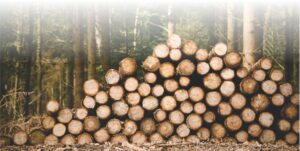
A Way Forward for Enhancing Production of good girth round logs
- May 20, 2023
- 0
The Central Government has taken certain decisive measures, to reduce the housing shortage in the country, which at present is estimated at around 50 million units. The Central Government’s policies – “Pradhan MantriAwasYojana”, to ensure ‘Housing for All by 2030’, and establishment of 100 smart cities. This will not only revive the Housing & Real Estate Sector in India, but will also lead to massive increase in demand, for solid wood& wood based panel products. This will boost establishment of many more new mfg. units, such as furniture, Medium Density Fibre Boards (MDF), Particle Boards and Bamboo-based Composites, in the near future.
The industry therefore needs to be supported in a big way, not only by promoting Agro-Forestry to ensure availability of their wood requirements on a sustainable basis, but also by relaxing / liberalizing the Licensing / Permits requirements for transportation and processing of Agro-Forestry Timber.
Demand for wood and wood products in India continues to grow, due to increasing population and economic development. These products are considered as “carbon neutral or even carbon negative” in terms of production, processing, use, recycling, and disposal at the end of service life. Such value added products can contribute significantly to “Circular Bio-economy”, by reducing energy consumption and carbon footprints by cutting down on non-renewable building.
Wood based industries in the country is diversified and so far most of the raw materials is grown outside forests, mainly under agro-forestry systems e.g. eucalyptus, poplar, silver oak, casuarina etc are being grown and/or utilized by pulp, paper ,plywood and other panel industries such as MDF,Particle board, laminates etc.
With the significant growth predicted for paper and plywood &panel industries, supply of raw material in future is also uncertain. On other hand, furniture, handicraft and other sectors have not received much attention or priority, with regard to supply of raw materials or development of tree improvement programme, focusing their needs. For example, furniture, joinery and handicraft hubs, based in Saharanpur and Jodhpur, are mainly utilizing mango, shisham and acacias and long term
supply of these species is unpredictable. There is also lack of link among research institutes, farmers, industry and other stakeholders. These situation results in over exploitation of few species and unsustainable wood utilization, which is resulting in loss of income and enthusiasm for farmers to plant trees and it results in causing shortage of raw material for industry and higher import bills.
India is a diverse country with a wide variety of underutilized tree species, due to lack of awareness about their potential uses. Thus, there is strong need to identify and prioritize tree species, with potential to meet the demand of wood based industries. In this regard Forest Development Corporations are likely to play a very productive role, by taking up following activity rather than limiting themselves in harvest and sale of wood.
Unfortunately, Government as such has not made any action plan or policy for the sustainable development of wood based Industry in the country. The current Licensing Norms and Transport Permits, especially for setting up of Agro-Forestry Timber based Units, and on movement of Agro Forestry Timber is a serious dampener to this Industry.
While Agro-forestry is fast gaining acceptance, the need of the hour is that more and more Agro Forestry Timber based industries / processing units come up in the country. While on one hand, Agro Forestry Plantations increase the Forest / Green cover in the country, it also supplements income of Farmers, reduces their dependence on Govt. for sale of traditional / cash crops. The Agro-Forestry Timber based industries / processing units, which are generally set up in near vicinity of plantation, will provide employment opportunity in rural areas, reduce migration to urban areas, thereby leading to overall balanced growth.
With abundant availability of Plywood and Other Panel Products such as MDF, PB, it will further pave the way for development of Organized Furniture Mfg. Units within the country, thereby reducing imports of furniture and saving precious foreign exchange. However for availability of good girth round logs, to meet the requirement of our saw milling and furniture grade sawn and seasoned timber our country is still depending on imported wood.
If really Government wants to substitute imported timber and produce saw quality logs from long rotation plantation timber spp, one of the best solution would be that Govt. lease the degraded forest land to Forest Development Corporations, who in turn enter into proper MOU with the user industry, without leasing the land to them and user agency have the right to undertake afforestation and take a fixed percentage of timber produce at the time of harvesting. This strategy will create good opportunity to states FDC who otherwise have not been involved much so far in producing quality raw materials.
Policy makers to take note that such strategy may lead minimising the wood import in future ahead. In this regard Forest Development Corporations are likely to play a very productive role by taking up following activity rather than limiting themselves in harvest and sale of wood.
1. Accelerate and increase forestry production by creating plantations of fast growing timber species, of higher economic value
2. Preparing a list of species capable of diversified use for industrial and commercial purposes.
3. To bring suitable forest areas under intensive Management Practices in order to improve, enrich and enhance production, both in quantity and quality.
4. To convert existing low quality forests into high quality productive forests by adopting intensive management system.
5. To formulate financially viable projects in order to draw institutional finance to execute its wood production and marketing activities.
6. To convert low valued/ degraded/ poor site quality forests into high value man made forests to obtain high quality produce for diversified uses.
7. Enhancement of productivity in Teak Plantation areas by scientific thinning.

अच्छि परिधि (मोटाई) वाले लॉग्स के उत्पादन को बढ़ाने का एक तरीका
केंद्र सरकार ने देश में आवास की कमी, जो वर्तमान में लगभग 5 करोड़ यूनिट अनुमानित है, को कम करने के लिए कुछ निर्णायक उपाय किए हैं। “2030 तक सभी के लिए आवास“ सुनिश्चित करने के लिए, केंद्र सरकार की नीतियां “प्रधान मंत्री आवास योजना“, और ‘‘100 स्मार्ट शहरों की स्थापना‘‘ है। यह न केवल भारत में आवास और रियल एस्टेट क्षेत्र को पुनर्जीवित करेगा, बल्कि ठोस लकड़ी और लकड़ी आधारित पैनल उत्पादों की मांग में भारी वृद्धि करेगा। इससे निकट भविष्य में, कई इकाइयां और नए उद्योगों की स्थापना को बढ़ावा मिलेगा। जैसे कि फर्नीचर, एमडीएफ (मध्यम घनत्व फाइबर बोर्ड), पार्टीकल (कण) बोर्ड और बांस-आधारित कंपोजिट बोर्ड।
इसलिए न केवल स्थायी आधार पर, लकड़ी की आवश्यकताओं की उपलब्धता सुनिश्चित करने के लिए, कृषि-वानिकी को बढ़ावा देकर बल्कि कृषि-वानिकी के परिवहन और प्रसंस्करण के लिए लाइसेंसिंग/परमिट आवश्यकताओं में ढील/उदारीकरण द्वारा भी, लकड़ी उद्योग को बड़े पैमाने पर समर्थन देने की आवश्यकता है।
बढ़ती आबादी और आर्थिक विकास के कारण, भारत में लकड़ी और लकड़ी के उत्पादों की मांग लगातार बढ़ रही है। उत्पादन, प्रसंस्करण, उपयोग, रीसाइकिं्लग और अंत में निस्तारन के मामले में, इन उत्पादों को “कार्बन तटस्थ या यहां तक कि कार्बन नकारात्मक“ माना जाता है। इस तरह के मूल्य वर्धित उत्पाद, गैर-नवीकरणीय भवन में कटौती करके ऊर्जा की खपत और कार्बन फुटपिं्रट को कम करके ‘‘जैव-अर्थव्यवस्था घेरे“ में महत्वपूर्ण योगदान दे सकते हैं।
देश में लकड़ी आधारित उद्योगों में विविधता है और अब तक मुख्य रूप से कृषि-वानिकी प्रणालियों के तहत वनों के बाहर उगाए जाने वाले अधिकांश कच्चे माल (जैसे सफेदा, पोपलर, सिल्वर ओक, कैसुरिना आदि) को लुगदी, कागज, प्लाईवुड और अन्य पैनल उद्योग जैसे एमडीएफ, पार्टिकल बोर्ड, लेमिनेट्स आदि द्वारा उगाया और/या उपयोग किया जा रहा है।
कागज और प्लाईवुड और पैनल उद्योगों की गौरवमय वृद्धि के बावजुद भविष्य में कच्चे माल की आपूर्ति अनिश्चित है। दूसरी ओर, फर्नीचर, हस्तकला और अन्य क्षेत्रों को कच्चे माल की आपूर्ति या उनकी जरूरतों का ध्यान देते हुए, वृक्ष सुधार कार्यक्रम के विकास के संबंध में, अधिक ध्यान या प्राथमिकता नहीं मिली है। उदाहरण के लिए, सहारनपुर और जोधपुर में स्थित फर्नीचर, बढ़ईगीरी (जोयनरी) और हस्तकला केंद्र, मुख्य रूप से आम, शीशम और बबूल का उपयोग कर रहे हैं और इन प्रजातियों की दीर्घकालिक आपूर्ति अपूर्वानुमेय या अनिश्चित है। अनुसंधान संस्थानों, किसानों, उद्योग और अन्य हितधारकों के बीच, संपर्क का भी अभाव है। इन स्थितियों के परिणामस्वरूप, कुछ प्रजातियों का अत्यधिक दोहन होता है और लकड़ी का अस्थिर उपयोग होता है, जिसके परिणामस्वरूप किसानों की आय में कमी आती है और पेड़ लगाने का उत्साह कम होता है और इसके परिणामस्वरूप उद्योग के लिए कच्चे माल की कमी होती है और आयात बिल बढ़ता है।
भारत एक विविधतापूर्ण देश है जहां पेड़ों की व्यापक विविधता है, क्योंकि उनके संभावित उपयोगों के बारे में जागरूकता की कमी है। इस लिए, लकड़ी आधारित उद्योगों की मांग को पूरा करने की क्षमता वाले पेड़ की प्रजातियों की पहचान करने और उन्हें प्राथमिकता देने की प्रबल आवश्यकता है। इस संबंध में वन विकास निगमों द्वारा खुद को, लकड़ी की कटाई और बिक्री तक सीमित रखने के बजाय, अधोलिखित गतिविधि करके एक बहुत ही उत्पादक भूमिका निभाने की प्रबल संभावना है।
दुर्भाग्य से, सरकार ने देश में लकड़ी आधारित उद्योग के सतत् विकास के लिए, कोई कार्य योजना या नीति नहीं बनाई है। वर्तमान लाइसेंसिंग मानदंड और परिवहन प्रपत्र (परमिट), कृषि-वानिकी लकड़ी आधारित इकाइयों की स्थापना के लिए, और कृषि वानिकी लकड़ी की आवाजाही के लिए विशेष रूप से एक गंभीर बाधा है।जबकि कृषि-वानिकी तेजी से स्वीकृति प्राप्त कर रही है, समय की मांग है कि देश में अधिक से अधिक, कृषि वानिकी लकड़ी आधारित उद्योग/प्रसंस्करण इकाइयां स्थापित हों। जहाँ एक ओर कृषि वानिकी वृक्षारोपण, देश में वन/हरित आवरण को बढ़ाता है, वहीं यह किसानों की आय में भी वृद्धि करता है, सरकार को परंपरागत/नगद फसल की बिक्री पर उनकी निर्भरता को कम करता है। कृषि-वानिकी लकड़ी आधारित उद्योग/प्रसंस्करण इकाइयां, जो आम तौर पर वृक्षारोपण के आसपास के क्षेत्र में स्थापित की जाती हैं, ग्रामीण क्षेत्रों में रोजगार के अवसर प्रदान करेंगी, शहरी क्षेत्रों में स्थानांतरण को कम करेंगी, जिससे समग्र संतुलित विकास होगा।
प्लाइवुड और एमडीएफ, पार्टीकल बोर्ड जैसे अन्य पैनल उत्पादों की प्रचुर उपलब्धता, देश के भीतर संगठित फर्नीचर विनिर्माण इकाइयों के विकास का मार्ग प्रशस्त करेगा, जिससे फर्नीचर के आयात में कमी आएगी और कीमती विदेशी मुद्रा की बचत होगी। हालांकि हमारे आरा मिल और फर्नीचर ग्रेड के लिए चिरी हुई प्रसंस्कृत लकड़ी की आवश्यकता को पूरा करने के लिए अच्छी परिधि (मोटाई) वाले गोल लॉग की उपलब्धता के लिए, हमारा देश अभी भी आयातित लकड़ी पर निर्भर है।
अगर सरकार वास्तव में आयातित लकड़ी का प्रतिस्थापन और लंबी अवधि के कृषिवाणिकी पेड़ों का उत्पादन करना चाहती है तो सबसे अच्छे समाधानों में एक यह होगा कि सरकार अवक्रमित (डिग्रेडेड) वन भूमि को, वन विकास निगमों को पट्टे पर दें, जो बदले में उपयोगकर्ता उद्योग के साथ उन्हें भूमि पट्टे पर दिए बिना, उचित समझौता करें और उपयोगकर्ता एजेंसी को वनीकरण करने और कटाई के समय, लकड़ी की उपज का एक निश्चित प्रतिशत लेने का अधिकार मिले। यह रणनीति, राज्य वन विभाग के लिए अच्छे अवसर पैदा करेगी जो अन्यथा गुणवत्ता वाले कच्चे माल के उत्पादन में अब तक ज्यादा प्रभावकारी नहीं हैं।
नीति निर्माताओं को ध्यान देना चाहिए कि ऐसी रणनीति, भविष्य में लकड़ी के आयात को कम करने में महत्वपूर्ण भूमिका अदा कर सकती है। इस संबंध में वन विकास निगम, लकड़ी की कटाई और बिक्री में खुद को सीमित करने के बजाय, निम्नलिखित गतिविधि करके एक बहुत ही उपयोगी भूमिका निभाने की संभावना खोज सकते है।
1. उच्च आर्थिक मूल्य की, कम अवधि वाली लकड़ी की प्रजातियों का वृक्षारोपण करके, वानिकी उत्पादन को तेजी से बढ़ा सकते हैं।
2. औद्योगिक और वाणिज्यिक उद्देश्यों के लिए विविध उपयोग में सक्षम प्रजातियों की सूची तैयार करना।
3. उत्पादन की मात्रा और गुणवत्ता दोनों में सुधार, संवर्धन और वृद्धि के लिए, गहन प्रबंधन प्रथाओं के तहत, उपयुक्त वन क्षेत्रों को शामिल करना।
4. वर्तमान के निम्न गुणवत्ता वाले वनों को, सघन प्रबंधन प्रणाली अपनाकर, उच्च गुणवत्ता वाले उत्पादक वनों में परिवर्तित करना।
5. अपनी लकड़ी के उत्पादन और विपणन गतिविधियों को निष्पादित करने हेतु, संस्थागत वित्त आकर्षित करने के लिए, वित्तीय रूप से व्यवहार्य परियोजनाओं को तैयार करना।
6. कम मूल्यवान/अवक्रमित/खराब साइट गुणवत्ता वाले वनों को, विविध उपयोगों के लिए, उच्च गुणवत्ता वाले उत्पाद प्राप्त करने के लिए, उच्च मूल्य वाले मानव निर्मित वनों में परिवर्तित करना।
7. वैज्ञानिक निष्कासन (छंटाई) द्वारा सागौन (टीक) बागान क्षेत्रों में उत्पादकता में वृद्धि।

































































